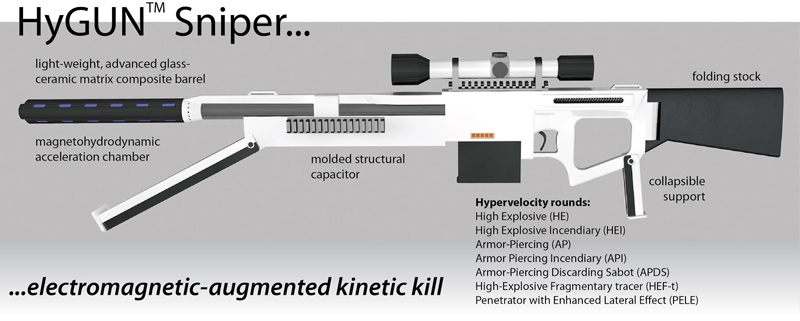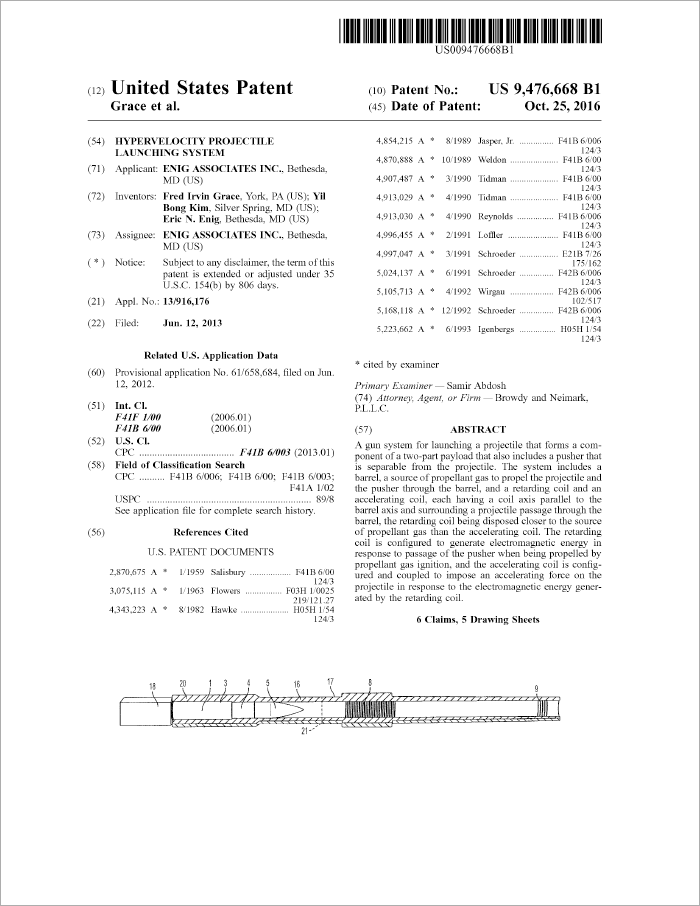 In 2013, senior leadership within Lockheed Martin Missiles & Fire Control (LMMFC), as well as the Office of the Secretary of Defense’s (OSD) Weapons Systems Office, gave ENIG the informal challenges of developing the capability to deliver a muzzle velocity ranging from 2 to 3.5 km/sec. OSD, in particular, was interested in an unconstrained gun.
In 2013, senior leadership within Lockheed Martin Missiles & Fire Control (LMMFC), as well as the Office of the Secretary of Defense’s (OSD) Weapons Systems Office, gave ENIG the informal challenges of developing the capability to deliver a muzzle velocity ranging from 2 to 3.5 km/sec. OSD, in particular, was interested in an unconstrained gun.
“OSD is charged with getting out ahead of the incremental stagnation that has been holding back gun research and development. Nobody is building a new gun, but if they were, what would it need to look like, in order to deliver lethality against a moving platform,” noted ENIG President, Eric N. Enig.
The solution? ENIG’s newly-patented (U.S. Patent 9,476,668) Hypervelocity Projectile Launching System technology offers warfighters a revolutionary advancement in scalability and brings small-to-medium caliber platforms into the lower bounds of the currently-elusive, hyper-velocity regime, not currently achievable by conventional propellant-based platforms.
“HyGUN™, as we refer to it at ENIG, offers the Services a robust technology for reevaluating current warfighter platforms and capabilities. Presently, ENIG’s technical staff are focused on developing a stable, rugged 20 mm and/or 25 mm diameter bore platform. We see technical challenges, though no deal breakers”, noted Enig, who stated the company’s HyGUN™ roadmap envisions scaling up to medium- and large-caliber platforms, near-term.
How does HyGUN™ work?
The conversion mechanism and efficiency of chemical energy supplied by the propellant to projectile kinetic energy is reasonably well understood. There exists an upper limit of velocity to which a projectile mass can be accelerated. In conventional gun systems, final velocity is limited by (i) projectile mass, (ii) propellant mass, (iii) barrel length and (iv) the ability of the breech and barrel to withstand internal pressure from propellant combustion. Additionally, muzzle velocity is limited by the sound speed of the propellant gases that cause projectile acceleration. These limits, associated with the ability to produce higher projectile muzzle velocity, have impeded advances in modern gun technology with regard to improvements in range, accuracy, hits against highly maneuvering targets, and lethality.
Electromagnetic launch of projectiles is not limited by the sound speed of gaseous products. “As anticipated projectile velocities, perhaps as high as 4 to 5 kilometers per second are far below the electromagnetic limit, and as electromagnetic launch does not involve gases, there is no limiting factor for the cited velocity ranges of interest”, added Enig.
ENIG’s patented HyGUN™ technology uses a combination of conventional propellant projectile launch and electromagnetic energy to boost the projectile to a very high velocity. In the process, additional energy is supplied to the system by expending additional propellant. The electromagnetic energy is obtained by converting chemical energy from the additional propellant to kinetic energy and subsequently converting that kinetic energy to electromagnetic energy using a system of decelerating coils. The electrical energy is then reapplied through another series of accelerating coils to boost the projectile from the velocity provided by propellant to much higher velocity. Such a system for accelerating projectiles has clear advantages in that (i) it uses available propellant as a compact power source, (ii) undue large exterior power sources are not required, and (iii) the energy is delivered in the appropriate time frame of projectile launch.

Where does HyGUN™ stand, as compared to other electromagnetic systems, such as rail gun?
“HyGUN™ is the elegant solution”, notes Enig, adding that “we’re taking the best of propellant and the best of coil to achieve a substantial leap in velocity and range. This we can do in a self-contained, cartridge-driven form-factor. We still require metallic barrels, breeches, cartridges, and propellants. For this reason, ground-based platforms – from squad level to vehicle-mounted and stationary weapons — are a natural fit, though I wouldn’t count out naval platforms. HyGUN™ removes the need for very large, very expensive pulsed power systems.”
(For more information, contact media@enig.com.)

